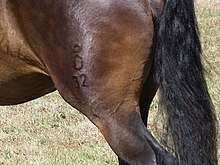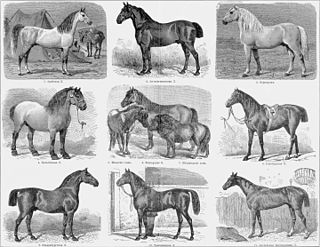
A horse breed is a selectively bred population of domesticated horses, often with pedigrees recorded in a breed registry. However, the term is sometimes used in a broader sense to define landrace animals of a common phenotype located within a limited geographic region, or even feral "breeds" that are naturally selected. Depending on definition, hundreds of "breeds" exist today, developed for many different uses. Horse breeds are loosely divided into three categories based on general temperament: spirited "hot bloods" with speed and endurance; "cold bloods," such as draft horses and some ponies, suitable for slow, heavy work; and "warmbloods," developed from crosses between hot bloods and cold bloods, often focusing on creating breeds for specific riding purposes, particularly in Europe.

The Groninger or Groningen is a Dutch horse breed developed for light draft and agricultural work. It is closely related to heavy warmblood breeds like the East Friesian and Alt-Oldenburger. The breed was nearly lost in the mid-20th century because a significant number of mares were used for crossbreeding to create the Dutch Warmblood, leaving few purebreds.

The Friesian is a horse breed originating in Friesland in north Netherlands. The breed nearly became extinct on more than one occasion. It is classified as a light draught horse, and the modern day Friesian horse is used for riding and driving. The Friesian horse is most known for its all-black coat colour, its long flowing mane and tail, feathering on its legs, a high head carriage, and high stepping action.

The Hanoverian or Hannoveraner is a German breed or stud-book of warmblood sport horse. As with other German warmblood breeds, eligibility for registration depends on performance rather than ancestry.

"English pleasure" is the generic term for a number of different English riding classes seen at horse shows in the United States, where the horse is ridden in either hunt seat or saddle seat tack.

The Oldenburg or Oldenburger is a warmblood horse from the north-western corner of Lower Saxony, what was formerly the Grand Duchy of Oldenburg. The breed was built on a mare base of all-purpose farm and carriage horses, today called the Alt-Oldenburger. The modern Oldenburg is managed by the Association of Breeders of the Oldenburger Horse, which enacts strict selection of breeding stock to ensure that each generation is better than the last. Oldenburgers are tall sport horses with excellent gaits and jumping ability. The breeding of Oldenburg horses is characterized by very liberal pedigree requirements and the exclusive use of privately owned stallions rather than restriction to a state-owned stud farm.

The Selle Français (SF) is a breed of sport horse from France. An athletic horse with good gaits, it is usually bay or chestnut in color. The Selle Français was created in 1958 when several French riding horse breeds were merged into one stud book. The new breed was meant to serve as a unified sport horse during a period when horses were being replaced by mechanization and were transforming into an animal used mainly for sport and leisure.

The Dole Gudbrandsdal, Dølahest, or Dole is a draft- and harness-type horse from Norway. The Dole Trotter is alternately considered a subtype of the Dole Gudbrandsdal and a separate breed; it is also considered a part of the coldblood trotter type. The Dole Gudbrandsdal is a small draft horse, known for its pulling power and agility, while the Dole Trotter is a smaller, faster horse used for harness racing. The two types were previously commonly interbred, but the studbooks have been separate since 2000 and since 2016 the criteria for entry into the Gudbrandsdal horse studbook has required a strict critique of eligible mares. The Dole is originally from the Gudbrandsdal Valley, and is probably descended in part from the Friesian horse. Over time, the breed has had Thoroughbred, Arabian, and other breeds added in, especially during the creation of the Dole Trotter in the 19th century. The first studbook was created in 1941, and the current breed association was formed in 1947. Although originally used mainly as a pack horse, today, the heavier Dole type is used mainly for agricultural purposes. The Dole Gudbrandsdal been crossed with other breeds to develop horses for harness racing and riding.

A Dutch Warmblood or KWPN is a horse breed of warmblood type registered with the Royal Warmblood Studbook of the Netherlands [Koninklijk Warmbloed Paardenstamboek Nederland] (KWPN), which governs the breeding of competitive dressage and show jumping horses, as well as the show harness horse and Gelderlander, and a hunter studbook in North America. Developed through a breeding program that began in the 1960s, the Dutch Warmbloods are some of the most successful competition horses developed in postwar Europe.
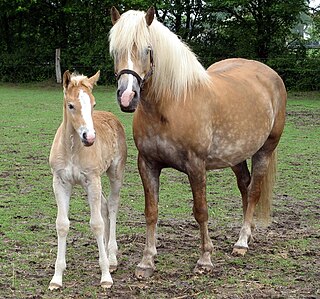
The Haflinger, also known as the Avelignese, is a breed of horse developed in Austria and northern Italy during the late 19th century. Haflinger horses are relatively small, are always chestnut with flaxen mane and tail, have distinctive gaits described as energetic but smooth, and are well-muscled yet elegant. The breed traces its ancestry to the Middle Ages; several theories for its origin exist. Haflingers, developed for use in mountainous terrain, are known for their hardiness. Their current conformation and appearance are the result of infusions of bloodlines from Arabian and various European breeds into the original native Tyrolean ponies. The foundation sire, 249 Folie, was born in 1874; by 1904, the first breeders' cooperative was formed. All Haflingers can trace their lineage back to Folie through one of seven bloodlines. World Wars I and II, as well as the Great Depression, had a detrimental effect on the breed, and lower-quality animals were used at times to save the breed from extinction. During World War II, breeders focused on horses that were shorter and more draft-like, favored by the military for use as packhorses. The emphasis after the war shifted toward animals of increased refinement and height.
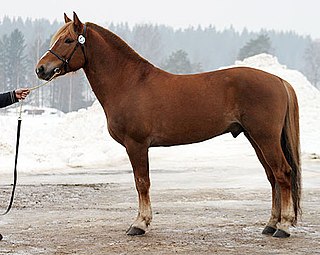
The Finnhorse or Finnish Horse is a horse breed with both riding horse and draught horse influences and characteristics, and is the only breed developed fully in Finland. In English it is sometimes called the Finnish Universal, as the Finns consider the breed capable of fulfilling all of Finland's horse needs, including agricultural and forestry work, harness racing, and riding. In 2007, the breed was declared the official national horse breed of Finland.
Florencio is a horse that won the 2004 World Championships for Young Dressage Horses in the five-year-old division. He was the only horse to receive a mark of "10" in the 2004 competition, and he received the highest marks total ever given to a combination at the World Championship for Young Horses. He stands at 16.2 hh (1.68m) and is registered in the following stud books: Westfalen, Oldenburg, NRPS, Hannover, AES, Sweden. His current rider is Hans Peter Minderhoud from.

The American Warmblood is a horse of warmblood type, intended primarily for the traditional sport horse disciplines of dressage, show jumping, eventing and combined driving.

The Westphalian or Westfalen is a warmblood horse bred in the Westphalia region of western Germany. The Westphalian is closely affiliated with the state-owned stud farm of Warendorf, which it shares with the Rhinelander. Since World War II, the Westphalian horse has been bred to the same standard as the other German warmbloods, and they are particularly famous as Olympic-level show jumpers and dressage horses. Next to the Hanoverian, the Westphalian studbook has the largest breeding population of any warmblood in Germany.

The Bavarian Warmblood is a horse breed of southern Germany that developed from an older Bavarian heavy warmblood breed called the Rottaler. Since mechanization in the mid-20th century, the Bavarian Regional Horse Breeders' Society has concentrated on producing a riding horse for the Olympic disciplines and recreational riding based on other European warmblood bloodlines.
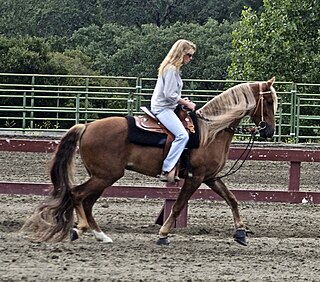
The Kentucky Mountain Saddle Horse is a horse breed from the U.S. state of Kentucky. Developed as an all-around farm and riding horse in eastern Kentucky, it is related to the Tennessee Walking Horse and other gaited breeds. In 1989 the Kentucky Mountain Saddle Horse Association (KMSHA) was formed, and in 2002, the subsidiary Spotted Mountain Horse Association (SMHA) was developed to register Kentucky Mountain Saddle Horses with excessive white markings and pinto patterns. Conformation standards are the same for the two groups of horses, with the main difference being the color requirements. The KMSHA studbook is now closed to horses from unregistered parents, although it cross-registers with several other registries, while the SMHA studbook remains open.
An Austrian Warmblood is a warmblood type of horse registered with the Arbeitsgemeinschaft für Warmblutzucht in Österreich. Although the studbook is made up of jumping and dressage horses from many other countries, the mare base consists of native horses with a long history. The AWÖ keeps an open studbook, in which mares and stallions must pass rigorous inspections before becoming breeding stock.
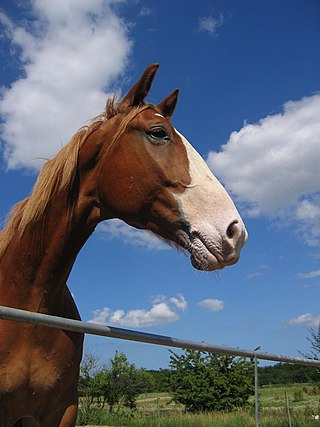
The Frederiksborger is Denmark's oldest horse breed. They were tremendously popular throughout the Renaissance and Baroque periods and were considered luxury items. Today, the breed is rare, but has a loyal following. Stallions and mares undergo studbook inspections before being allowed to breed. They are most often chestnut with white markings.

The Zweibrücker is a type of German warmblood horse bred in Rhineland-Palatinate and Saarland. Traditionally, the breeding of Zweibrücken was centered on the onetime Principal Stud of Zweibrücken but since 1977 has been under the jurisdiction of the Horse Breeders' Association of Rhineland-Palatinate-Saar (PRPS). The modern Zweibrücker is an elegant, large-framed, correct sport horse with powerful, elastic gaits suitable for dressage, show jumping, eventing and combined driving.

This is a basic glossary of equestrian terms that includes both technical terminology and jargon developed over the centuries for horses and other equidae, as well as various horse-related concepts. Where noted, some terms are used only in American English (US), only in British English (UK), or are regional to a particular part of the world, such as Australia (AU).
